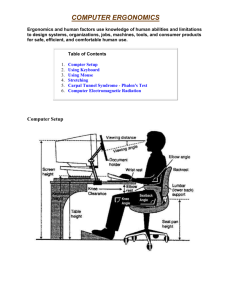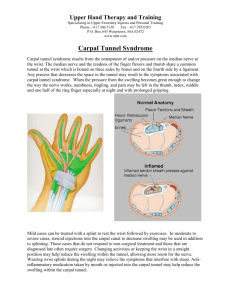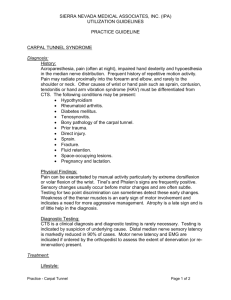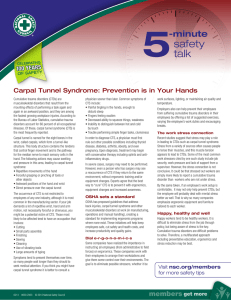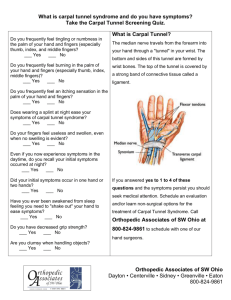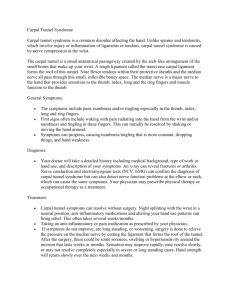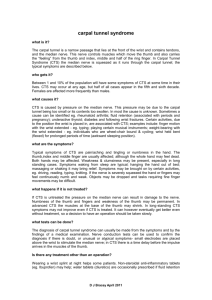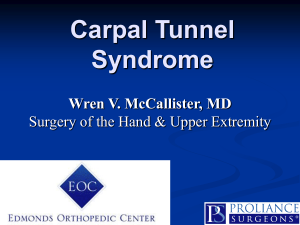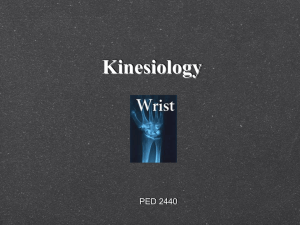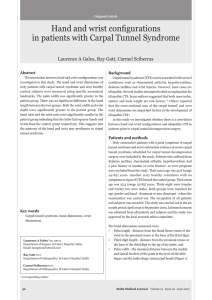Computer Related Health Hazards
advertisement
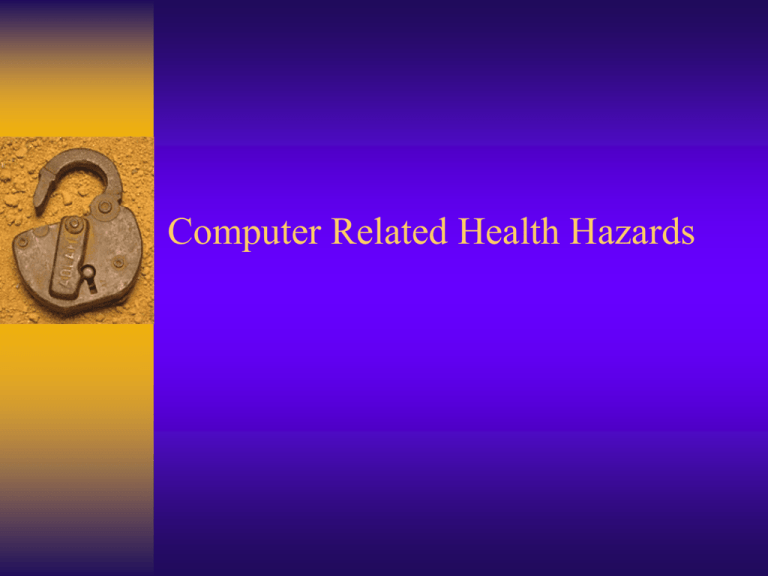
Computer Related Health Hazards Research Topics Repetitive Strain Injuries Carpal Tunnel Syndrome Eye Strains and Computer Vision Syndrome Internet Addiction Stress and Depression Radiation Carpal Tunnel Syndrome Carpal Tunnel Syndrome (CTS) is a Repetitive Stress Injury (RSI) caused when the median nerve is pushed by the flexor tendons inside the tunnel made up of the wrist bones, or carpals. How is CTS caused The forearm flexor tendons and a few nerves pass through a small tunnel formed by the wrist bones, or carpals, into the hand. As you move you hands and fingers, the flexor tendons rub against the sides of the tunnel, sometimes causing them to swell and push the median nerve. When the median nerve is pushed by the tendons, we feel pain. Symptoms of CTS injury Pain that may run up the hand into the wrist and arm Numbness and coldness in the hands Loss of strength and/or joint movement Discomfort and stiffness in the hands The need to massage your hands, wrists and arms Swelling and coldness in the hand Reasons for CTS injury Stress will increase muscle tension causing pain Long hours in the keyboard, especially those that type more than four hours Lack of circulation in the muscles that prevents nutrients and oxygen to reach the tissues Inadequate rest and breaks Genetic predisposition due to the amount of lubrication of the flexor tendons that one receives and the tunnel's geometry Other health problems like diabetes and rheumatoid arthritis Poor posture including the sitting, placement of hands on the keyboard and proper height of the keyboard Poor diet (lack of vitamins) CTS Treatment Rest, rest and more rest Use of a wrist brace or splint Take medication like ibuprofen Cut back on sugar, caffeine, alcohol and take vitamins Keep hands warm, take breaks, exercise your hands and arms Correct your typing and use your knowledge of ergonomics Surgery should be your last retreat if everything else fails Eye Strains Eye strain is the single largest complaint of VDT users causing soreness, irritation, blurred vision, redness, dryness and tenderness of the eyes. Symptoms of Eye Strains Impaired vision, double vision and blurred vision Difficulty looking at one point for a period of time Itchy dry eyes and discomfort while looking at the VDT Headaches Eye fatigue that can have serious impact later in life Reasons for this injury Bad monitor resolution, flickering, or glare at the monitor Poor lighting conditions in the computer room Electromagnetic radiation emitted by the VDT (UVA) Staring at anything for a long period of time will cause blurred vision Loss of negative ions in the atmosphere due to electrostatic charges on the face of the CRT Eye Strain Treatment Use your knowledge of ergonomics Take breaks when you feel strained Use your laptop when possible because the monitor emits less radiation Adjust the brightness of your screen Wear protective eye glasses Internet Addiction Use Internet every day without days off Loosing track of time while surfing the Net Staying home more loosing social contacts Denial of high usage 51% of Internet addicts suffer severe job impairment 58% get addicted within the first 12 months of Internet usage Stress and Depression Computer operators experience more stress than any other occupational group the National Institute of Occupational Safety and Health has studied Other Computer Related Health Hazards Back problems (pain) caused from the efforts of the muscle to hold your posture for long periods of time Skin rashes that are caused from the static fields in front of the screen causing ions and pollutants in the air to become positively charged and attach themselves to your negatively charged skin (especially in low humidity) Abnormal reproductive outcomes (?) due to electromagnetic radiation's affects on biological functions and biochemical processes inside our cells Cancer and leukemia (?) Skin aging (?) Ergonomics Ergonomics, the "science of work," is a field of technology that considers human capabilities and limitations in the design of machines and objects that people use, the work processes that they must follow, and the environments in which they operate." A few ergonomic advice Use a chair that has full support of your back, is adjustable, and has a footrest and armrest Place your feet firmly on the floor Use an ergonomic keyboard that is angled or can split to enjoy a more natural typing position Use a wrist rest that is comfortable Place your hands straight when typing, the angle of your forearm and upper arm should be 90 degrees Sit 24 to 28 inches away from your monitor Place the monitor 15-30 degrees below your straight-ahead line of sight Keep your body away from the sides and backs of monitors to reduce the exposure of radiation Avoid glare on your monitor (do not have strong sources of light in your back) and use screens that minimize glare Use the proper light in your work environment that is compatible with the monitor frequency
